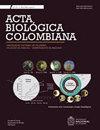鱼类遗传变异性及繁殖特性
IF 0.5
4区 生物学
Q4 PLANT SCIENCES
引用次数: 0
摘要
从巴西不同渔场获得的养殖斑马鱼样本可能由于圈养环境中的遗传漂移和选择压力而表现出遗传变异和等位基因频率的改变,从而导致生产和繁殖特征的分化。本研究的目的是评估来自六个巴西渔场的180个斑马鱼标本的遗传变异性和繁殖特征。在所有评估的股票中都观察到与Hardy-Weinberg平衡的偏差。在观察到的杂合性和近交系数(FIS)的遗传变异量方面,观察到种群之间的分化。通过Fst指数确定种群之间的遗传距离,并根据Nei的遗传距离绘制树状图,观察四个不同类群的形成。观察到生殖参数之间的差异,如每只雌性的平均卵子数量和孵化率。第二个参数被证明与种群的近亲繁殖水平有关,而产卵频率没有观察到这种影响。我们得出的结论是,来自6个不同巴西渔场的斑马鱼种群具有显著的遗传和表型变异性。遗传结构影响生殖能力,在进行评估生殖率的工作时应加以考虑。本文章由计算机程序翻译,如有差异,请以英文原文为准。
GENETIC VARIABILITY AND REPRODUCTIVE CHARACTERISTICS OF ZEBRAFISH (Cyprinidae Danio rerio) STOCKS
Specimens of cultured zebrafish acquired from different fish farms in Brazil may show genetic variability and alteration in allele frequency due to genetic drift and selective pressure in a captive environment, resulting in the differentiation of productive and reproductive characteristics. The aim of this study was to evaluate the genetic variability and reproductive characteristics of 180 zebrafish specimens from six Brazilian fish farms. A deviation from the Hardy-Weinberg equilibrium was observed in all evaluated stocks. Differentiation among stocks was observed in the amount of genetic variability with respect to observed heterozygosity and the inbreeding coefficient (FIS). Genetic distance between stocks was determined through the Fst index, and the formation of four distinct groups was observed by plotting the dendrogram based on Nei’s genetic distance. Differences were observed among reproductive parameters, such as the average number of eggs per female and hatchability. This second parameter proved to be related to the level of inbreeding of the population, whereas this effect was not observed for spawning frequency. We conclude that zebrafish stocks from the 6 different Brazilian fish farms present significant genetic and phenotypic variability. The genetic structure affects fecundity and should be considered when carrying out work where reproductive rates are evaluated.
求助全文
通过发布文献求助,成功后即可免费获取论文全文。
去求助
来源期刊

Acta Biologica Colombiana
Agricultural and Biological Sciences-General Agricultural and Biological Sciences
CiteScore
1.60
自引率
0.00%
发文量
21
审稿时长
13 weeks
期刊介绍:
The journal is published quarterly and divulges original and unpublished results of basic and applied research about biological subjects with special interest in Neotropical region. Manuscripts may be research articles, reviews, reflection articles or short notes. The Acta biol. Colomb Journal have a scientific and editorial board composed of expert researchers of in their areas of knowledge.
 求助内容:
求助内容: 应助结果提醒方式:
应助结果提醒方式:


